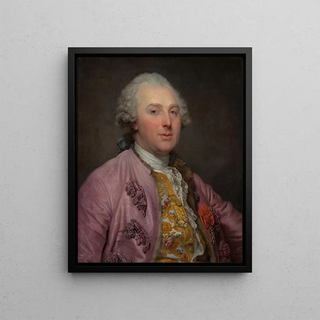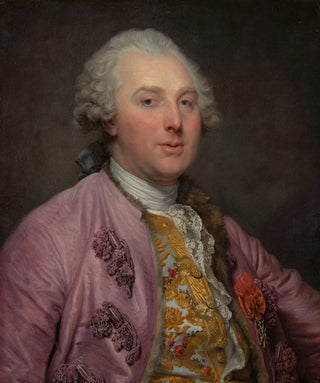Art print | Charles Claude de Flahaut 1730-1809 Count of Angiviller - Jean-Baptiste Greuze


View from behind

Frame (optional)
The art print of the work "Charles Claude de Flahaut 1730-1809 Count d'Angiviller" by Jean-Baptiste Greuze immerses us in an era where art and society intertwine in a fascinating way. This portrait, depicting a man of power and prestige, is much more than a simple representation. It embodies a vision of French nobility in the 18th century, a moment when art becomes the reflection of the ambitions and values of its time. By examining the details of this piece, the viewer is invited to explore the subtleties of Count d'Angiviller's personality, while discovering Greuze's refined painting techniques, which manage to capture the very essence of his subject.
Style and uniqueness of the work
Jean-Baptiste Greuze's style is distinguished by an intimate and emotional approach, characterized by soft colors and delicate expressions. In this portrait, Greuze succeeds in blending realism and idealization, offering a vision that is both faithful and beautified of his model. The play of light and shadow, as well as the texture of the clothing, testify to the artist's virtuosity, who manages to bring the canvas to life. The piercing gaze of Count d'Angiviller, imbued with a certain melancholy, invites the viewer to question the thoughts and feelings that animate him. This portrait does not merely depict a man; it also evokes a transitional era, where aristocratic values begin to be questioned. The way Greuze manages to capture this duality makes this work a true masterpiece of its time.
The artist and his influence
Jean-Baptiste Greuze, often regarded as one of the masters of 18th-century portraiture, knew how to mark his era with his unique style and his ability to convey deep emotions through his works. Trained in the studio of the academician François Boucher, Greuze quickly developed an aesthetic that was his own, diverging from the academic conventions of his time. His influence extends beyond his era,

Matte finish

View from behind

Frame (optional)
The art print of the work "Charles Claude de Flahaut 1730-1809 Count d'Angiviller" by Jean-Baptiste Greuze immerses us in an era where art and society intertwine in a fascinating way. This portrait, depicting a man of power and prestige, is much more than a simple representation. It embodies a vision of French nobility in the 18th century, a moment when art becomes the reflection of the ambitions and values of its time. By examining the details of this piece, the viewer is invited to explore the subtleties of Count d'Angiviller's personality, while discovering Greuze's refined painting techniques, which manage to capture the very essence of his subject.
Style and uniqueness of the work
Jean-Baptiste Greuze's style is distinguished by an intimate and emotional approach, characterized by soft colors and delicate expressions. In this portrait, Greuze succeeds in blending realism and idealization, offering a vision that is both faithful and beautified of his model. The play of light and shadow, as well as the texture of the clothing, testify to the artist's virtuosity, who manages to bring the canvas to life. The piercing gaze of Count d'Angiviller, imbued with a certain melancholy, invites the viewer to question the thoughts and feelings that animate him. This portrait does not merely depict a man; it also evokes a transitional era, where aristocratic values begin to be questioned. The way Greuze manages to capture this duality makes this work a true masterpiece of its time.
The artist and his influence
Jean-Baptiste Greuze, often regarded as one of the masters of 18th-century portraiture, knew how to mark his era with his unique style and his ability to convey deep emotions through his works. Trained in the studio of the academician François Boucher, Greuze quickly developed an aesthetic that was his own, diverging from the academic conventions of his time. His influence extends beyond his era,






